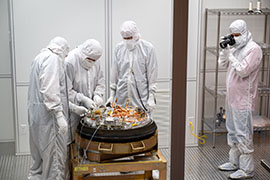- Slug: BC-CNS-Space Dirt,700 words.
- 4 photos available (thumbnails, captions below).
By Lux Butler
Cronkite News
WASHINGTON – A University of Arizona scientist joined NASA officials Wednesday to unveil the results of a successful multiyear mission to a near-Earth asteroid that returned last month bearing what they called “scientific treasure.”
OSIRIS-REx set multiple records on its seven-year trip to the asteroid Bennu, where it collected four times as much material as planned – material including carbon and water-bearing clay that could hold clues to the development of Earth.
“I spent the weekend staring at this image for hours and hours and getting more excited by the day,” said Dante Lauretta, a professor at the University of Arizona, one of the leads on the project.
Lauretta and other researchers are excited by the roughly 250 grams of dirt and rocks that landed Sept. 24 in the Utah desert in a canister that they have not even opened yet – but which held an overflow of dust that they have started to analyze.
“Everything is a new discovery as we are glimpsing the early part of the development of this magnificent thing called the universe,” NASA Administrator Bill Nelson said during a press event Wednesday.
The event was the culmination of years of work on the Origins, Spectral Interpretation, Resource Identification and Security – Regolith Explorer – shortened to OSIRIS-REx – that began as a project at the University of Arizona’s College of Science’s Lunar and Planetary Laboratory.
Launched in 2016, the $800 million spacecraft took four years to reach Bennu, a rocky, carbon-rich asteroid about one-third of a mile wide at its equator. Once there, it performed a tricky touch-and-go maneuver in which a spacecraft arm touched down on the asteroid surface for a matter of seconds, kicking up dust that was collected in a canister before heading back to space – and to Earth.
One reason Bennu was chosen was its age – it is believed to be as many as 4.5 billion years old. Researchers hope the material gathered there will give insight into the history of Earth.
“We picked the right asteroid. And not only that we brought back the right sample,” said Daniel Glavin, OSIRIS-REx sample analysis lead at the NASA Goddard Space Flight Center. “This stuff is an astrobiologist’s dream.”
OSIRIS-REx flew by Earth last month and jettisoned the Touch-And-Go Sample Acquisition Mechanism, the collection canister that touched down on Bennu. The TAGSAM landed in Utah on Sept. 24 and was taken to NASA’s Johnson Space Flight Center in Houston.
Officials said analysis of the contents has been slowed by the fact that material from the asteroid has been found on the outside of the canister, a bonus for researchers before they fully open it.
Glavin said samples that have been analyzed so far reveal the “highest abundance of carbon they’ve ever measured in any extraterrestrial sample.” Not only was the original search for carbon successful, but there were also water-bearing clay minerals, sulfur and iron brought back from the asteroid.
“The reason that Earth is a habitable world, that we have oceans and lakes and rivers and rain, is because these clay minerals, like the ones we’re seeing from Bennu, landed on Earth 4 billion years ago to 4.5 billion years ago, making our world habitable,” Lauretta said.
The sulfur, iron and carbon found in the Bennu samples, could also play crucial roles in revealing more of Earth’s history. Lauretta, a sulfide mineralogist, said he is most excited to “get inside” of the sulfurous materials that were brought back and see what”s going on.
Scientists at NASA predict they will have around 250 grams of sample material once they open the canister, more than four times the amount they had intended to bring home. The material will then be divided up and sent for analysis to laboratories around the world, including to the University of Arizona.
OSIRIS-REx will continue on to a rendezvous with another asteroid, Apophis, when it nears Earth in 2029. In the meantime, Glavin said the material from Bennu will be around for researchers to study “for generations and generations.”
That was echoed by Nelson.
“We are going to have answers to questions that we don’t even know what the questions are now,” Nelson said.
For more stories from Cronkite News, visit cronkitenews.azpbs.org.
^__=
Web links:
_ NASA page: https://science.nasa.gov/mission/osiris-rex
_ UArizona page: https://research.arizona.edu/osiris-rex
_ Bennu: https://science.nasa.gov/solar-system/asteroids/101955-bennu/
_ OSIRIS-APex: https://news.arizona.edu/story/bennu-sample-delivery-marks-start-extended-osiris-apex-mission^__=
^__=
Scientists at the Johnson Space Center in Houston began the process last month of examining contents of the OSIRIS REx canister that brought samples of the asteroid Bennu back to Earth after a seven-year mission. (Photo by Robert Markowitz/NASA)
A Lockheed Martin engineer performs preliminary checks on the sample return capsule from NASA’s OSIRIS-REx mission on Sept. 24, shortly after the capsule landed in the Defense Department’s Utah Test and Training Range. (Photo by Keegan Barber/NASA)
Workers process the sample return capsule from NASA’s OSIRIS-REx mission in a special clean room in northern Utah, where the capsule landed on Sept. 24 with soil samples from the asteroid Bennu. (Photo by Keegan Barber/NASA)
A series of images show OSIRIS-REx’s Touch-And-Go Sample Acquisition Mechanism as it neared the surface of Bennu in 2020, made contact and was engulfed by debris it kicked up and collected to carry to Earth. (Photo courtesy NASA)



